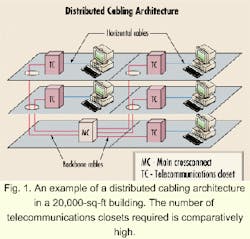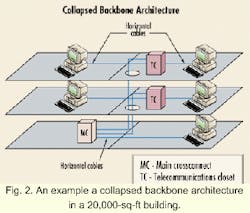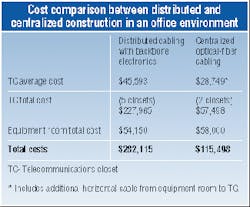Centralized cabling helps fiber come out of the telecom closet
An examination of the true cost of telecommunications closets reveals that hidden or overlooked savings make centralized cabling very attractive.
The long-distance data-transmission capabilities of fiber make it possible to dramatically cut local-area-network (LAN) ownership costs by using centralized-cabling architecture. The benefits of centralized cabling are simple. By extending cabling from the workstation through the telecommunications closet (TC) to a centralized crossconnect where the LAN electronics equipment is located, many costs associated with distributing full-size TCs throughout a building can be eliminated. The benefits can be substantial for most organizations when you consider that 45% of corporations have three or more closets per floor, according to research conducted by Digital Equipment Corp.
Additionally, centralized cabling means simplified management. With a simplified network configuration, there are fewer closets to be maintained, fewer points for potential failure, and less technician time spent on maintenance and troubleshooting going from closet to closet.
The ability to quantify savings due to centralized cabling makes an even stronger case for the use of this network design using optical fiber. To perform this quantification, it is important to get an accurate estimate of the true cost of building and maintaining TCs and the resultant savings from their elimination or re-engineering. Frequently, however, many of these costs have been overlooked. As a result, the cost savings attributed to reducing or re-engineering closets are often underestimated.
To appreciate the potential savings of centralized cabling, it is important to understand the true cost of TCs. While industry standards make recommendations about the precise size and design requirements of TCs, these specifications don't address the actual costs of the closets.
"When designing a network, most people don't pick up on the true cost of closets," says Tom Rauscher, president of Archi-Technology, LLC, a consulting firm based in Rochester, NY. "It's not just the closet and equipment that goes in it, but the internal and external design and project-management costs to build the closets, unforeseen costs such as asbestos removal in building renovations, utility shutdowns, modifications due to code, and even rent or department chargebacks."
According to Rauscher, many managers fail to think about the implications of the network in the design phase, so costs usually show up in the form of change orders that also affect timelines, scheduling, and coordination. "Technology requires infrastructure," says Rauscher. "Many people don't consider the overall impact on the architectural, mechanical, electrical, and even plumbing environments when choosing a cabling architecture."
"All of this has made it difficult to capture the true costs of closets and the real benefits of moving to a centralized architecture," he adds. Because actual cabling costs show up in a different line item, people don't relate these costs to infrastructure requirements.
Much of the cost of closets can be determined by examining construction requirements and size as recommended in standards. The EIA/TIA-569-A standard recommends sizes for telecom closets. While centralized cabling is not required for fiber-to-the-desk applications, its cost advantages make it an important consideration for new buildings and major cabling upgrades.
In a distributed network with a 10,000-sq-ft serving area, a 10x11-ft TC is recommended. For an 8,000-sq-ft serving area, a 10x7-ft TC is located on every floor to house electronic equipment. By using a collapsed, backbone architecture, it is possible to decrease the size of these closets to 4.5x2 ft by referring to sizes in an annex of the EIA/TIA-569-A standard. For even further reduction, the closet can function as a simple pass-through for both fiber and copper cable. Additionally, closets could potentially be spaced to service larger floor areas while staying within the limits of standards--even though the capabilities of fiber far exceed the distance limitations inherent in EIA/TIA-569A.
A comparison of cabling costs using centralized cabling versus distributed cabling for a three-story, 60,000-sq-ft building results in a cost savings of more than $172,000 in passive equipment and environmental-control cost savings for TCs and the equipment room. In this example, the building has a floor height of 12 ft and each of the three floors measures 20,000 sq ft.In this same building, centralized cabling can be used to reduce the number as well as the size of the TCs (see Fig. 2). Only two closets measuring 4.5x2 ft are required for the entire building, extending the cable as a pull-through in the TC. The equipment room for this centralized network requires more space and fewer electronics than for a distributed system. The equipment room would measure 1200 sq ft. When cabling costs are compared for this building, the savings using a centralized architecture is approximately $16,844 per closet (see Table).
The costs of the construction for telecom closets can vary with the type of building. Oftentimes, medical facilities have different requirements when factors such as average cost per square foot and displacement rates are considered. These costs may also differ among office buildings, manufacturing facilities, higher-education installations, and primary and secondary school campus-cabling projects.
Nonetheless, in each instance, centralized cabling can reduce the need for TCs, or minimize the associated costs like electrical, heating, air conditioning, and even controlled access entry, with the use of a simple cable pathway through a TC.
"By using a shallow closet with pass-throughs, you can minimize the impact on space usage even further," says Rauscher. A pass-through eliminates the need for a splice point or patch panel by pulling the cable straight through. However, caution is warranted in these designs because sometimes these longer runs may not be practical.
Other times, however, using only a pass-through is a cost-saving alternative. In some cases, one equipment room can serve an entire building by simply using pass-throughs to deploy cable throughout. This method is useful in environments like schools where there is limited room for even shallow closets and where there are few telephones or other equipment needing closet space.
By going to a shallow closet with pass-throughs, the impact on the current utility-space usage in a building can be minimized. This approach also reduces construction costs and the cost of network management. "Most importantly, backbone cabling doesn't have to be built, terminated, and tested. You only have the horizontal cable to manage, so this can be an area of significant cost savings," Rauscher says.
Because backbone pathways with high cable counts are vital to the nerve center of the organization, high stability and protection are critical. For example, backbone cables often carry 100 links. With horizontal cabling, most pathways carry only a few strands of fiber making the threat of major network outages less severe. An open support mechanism is sufficient with horizontal cabling as opposed to a contained pipe, which may be necessary for cabling from closet to closet in distributed cabling designs. Conduit for backbone pathways is typically designed with 4-in conduit.
When recabling for a network upgrade there are also some intangible costs. Displacement can be a serious issue for some organizations: Space is usually at a premium and there are costs involved with disrupting work and moving people's workspace.
"In some environments, especially in public schools, there is no available space to allocate for closets, especially when many states determine the minimum size requirements for classrooms," Rauscher explains. "In many instances, carving out a closet simply isn't an option. Just getting the space, much less taking it over for a closet, is a concern, and this has associated costs."
Some of the intangible costs seldom considered when making cabling decisions are the political issues created as information-technology (IT) departments lobby the rest of the organization for telecom-closet space. Conflict also arises over the question of which department pays the bill for floor space. Is it an IT infrastructure cost or is it a cost charged back to the department whose work area is being served from the closet?
Savings from closet reductions often vary with the architectural project. Trump Casino in Atlantic City is taking advantage of centralized cabling. The casino and convention facility experienced significant closet reductions by using a centralized fiber-based architecture throughout offices and point-of-sale terminals.
In moving from a network with a fiber backbone and copper cabling to the desk to a fiber-optic LAN, the casino reduced the number of telecom closets from 35 to five. According to the network manager, the casino saved almost $500,000 in the difference between copper and fiber.
Valuable technician time can be saved in troubleshooting and maintaining networking equipment especially in a large facility. Since the casino is three blocks long, it takes 10 to 15 min for a technician just to walk somewhere in the building. According to the network manager, for managing point-of-sale connections and NT servers, centralized cabling cuts technician work by one-third. The architecture allows them to tap into the switch in the computer room and look anywhere in the network from a central location.
In a campus environment, centralized cabling can have even greater impact. When George Washington University in Washington, DC, deployed fiber to the desktop of every student, faculty, and staff member on campus, the university experienced a reduction from 170 TCs throughout the campus to 11 centralized equipment sites using centralized cabling.
According to Guy Jones, director of technology, information systems, and services for GWU, a key deciding factor for the university to go with optical-fiber cabling was cost savings. These savings included not only the cost of fiber and fiber components but, most importantly, savings in space and construction.
"When I joined George Washington, there had already been a plan drawn to use copper," explains Jones. "One of the oversights I immediately found, however, was the plan assumed space was free and, second, cost estimates did not include the construction that would be required for the additional equipment rooms. It did not even provide for the kind of equipment rooms required for a new infrastructure of switched Ethernet with the ability to upgrade to Asynchronous Transfer Mode. Approximately 80% of the locations we were moving into would require some construction, and these costs were not being factored into the overall equation. Given that the university is in the heart of a very urban environment, the cost of existing space and the cost to construct new space are significant." According to Jones, the ability to decrease the number of equipment rooms by a factor of 10 was the dominant component of the cost equation.
While these applications used Volition cabling, significant savings have been achieved using standard fiber-optic cabling and components as well. Corning Inc. recabled a catalytic-converter manufacturing facility in Erwin, NY, using 62.5-micron fiber. The company was able to reduce the number of TCs in the 500,000-sq-ft facility from four closets to one. This closet reduction came at an estimated savings of $24,000 per closet.
At the new Getty Museum in Los Angeles, cabling of the 945,000-sq-ft complex on a 110-acre campus was completed using only one TC. Copper cabling would have required 55 closets.
Telephone-closet and network-administration space were at a premium for this 2400-node network, so the system architecture had to consume as little floor space as possible. By not scattering the switches among 55 closets, fewer switches were required, meaning the network could use 100% of each switch's capacity, resulting in a more efficient network. The additional space created by centralized cabling enabled Getty to put fire, security, and other systems into the TC space, allowing network designers to save on power and air conditioning costs.
Fiber was ultimately a more cost-effective solution than copper for several reasons. Using a centralized network administration and eliminating all the electronics between the desktop and computer room enabled the Getty complex to save space. There was no need for switches in telecommunications closets, which would have consumed about 100 sq ft per closet. With 55 TCs on-site, the savings totaled $5 million, enough to cover the cost of the entire cabling system. Getty IT managers claim the move to centralized cabling saved $73,000 per closet, or nearly $4 million in total.
While savings are expressed by most of these organizations in terms of closet cost savings, savings due to higher port utilization on electronics equipment were also realized. Since network electronics make up more than two-thirds of the cost of any local area network, savings in electronics costs can produce significant results for many organizations, even when using fiber cabling and media conversion with copper-based electronics.
"By centralizing closets," says Rauscher, the need for entire chassis can be eliminated throughout the premises. This also goes for management modules and power supplies." Elsewhere in the network, centralized cabling allows available ports to be used more efficiently. Because fewer ports go unused on network cards on the switch, the cost per port on each switch can be distributed among a greater number of users.
In an example of electronics savings for recabling a headquarters building, the IT manager for one Fortune 500 company wanted to upgrade the company's Ethernet network to 10-Mbit/sec switched instead of the 10-Mbit/sec shared networking in use for the past 11 years. The company's eventual goal was to migrate to 100-Mbit/sec switched networking over time. With an installed base of copper networking equipment and a desire to use 10/100-Mbit/sec Ethernet in the near future, an upfront investment in fiber-based switching products was not an option. Instead, the company decided to deploy centralized cabling using media conversion on copper switches.The 1.5-million-sq-ft facility, which houses 2400 users, had 42 TCs spread throughout with one hub located in each closet. A total of 42 copper-based 10/100-Mbit/sec Xylan switches were estimated at about $1.64 million as part of the network upgrade. By centralizing electronics, the company only needed 20 edge switches using 192 ports per chassis and an additional four core switches for uplinking the edge switches and the servers. Centralization also resulted in an increase in port utilization from about 25% on the old copper network configuration to 86% with centralized fiber-optic cabling. A savings of $854,000 in switch costs is attributed to the centralized network architecture.
When the company factored in $933,675 in labor and passive-component costs for recabling the facility, the combined passive and active costs for recabling with fiber was nearly $1.7 million. This total price for centralized cabling was a little more than the cost of the electronics alone using distributed cabling.
Centralized-cabling architecture uncovers many hidden savings when compared to a distributed architecture. When making any networking decision, it is important to assess the true cost of new installations or a cabling retrofit as accurately as possible. These calculations can be made by carefully factoring in four key areas of cost.
- Associated fees such as design and project management fees and fees to account for displacement of users should be considered.
- Physical closet costs are a main consideration. These costs include floor space, construction, conduit, equipment, and other supplies and should include the costs of backbone cabling, if applicable.
- Electronics costs, including the number of pieces of active equipment needed is an important element. Also, the capacity at which each piece of equipment will be used should be calculated in an effort to ensure maximum port utilization.
- Recurring costs such as HVAC, power, and rent or leaseback of space should be calculated.
By using accurate cost calculations, the true costs of closets can be accounted for in any organization, whether a centralized cabling architecture using optical-fiber cabling is used or if the decision is made to remain with a distributed network. Understanding the impact of technology decisions on building infrastructure when assessing the cost of telecommunications closets is key to making effective network-upgrade decisions.
Bob Jensen is the technical-services team leader for the Volition Fiber Optic Network Solution at 3M Telecom Systems Division (Austin, TX). He chairs the TIA subcommittee TR-42.2, Residential Cabling, and the TR-42.3 Pathway Fill Task Group; is editor of the Customer-owned OSP Standard; and secretary for TR-42. He is BICSI's designated alternate to Panel 16 of the National Electrical Code.



